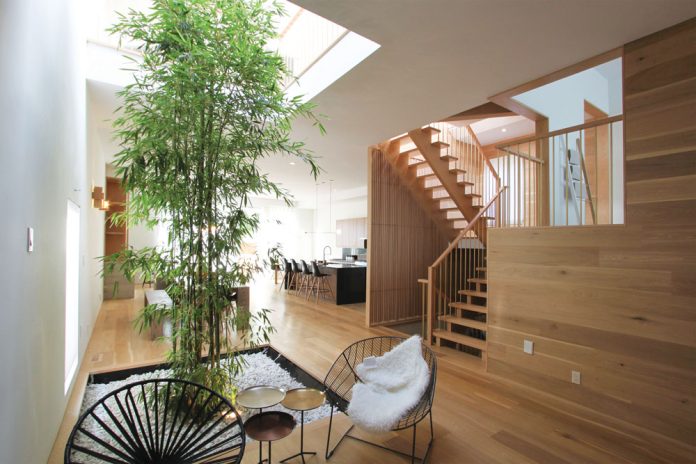By DC Rutherford
Andrew Sun knows the future.
The Toronto-based designer isn’t a prophet and he doesn’t have extrasensory perception, but that doesn’t make his foresight for Muskoka design and architecture any less prescient. The future, as Sun sees it, is Japandi.
Unfamiliar with Japandi? Not for long. The concept is “a combination of Scandinavian functionality and Japanese Zen and minimalism, a style that is both easygoing and sophisticated,” he says. And it’s primed to become the design ideology your neighbours claimed to be into years ago.
Sun explains, “Japandi features clean lines, natural textures and craftmanship. It creates a cozy and peaceful atmosphere, and harmonizes with surrounding nature. Being in Muskoka and surrounded by the beautiful trees and lakes, our goal is to create an architecture and interior space with simplicity and coziness that enhance the remarkable views, balance the light and shadow, and make the cottage a true extension of the beautiful landscape and a peaceful getaway from the hustle and bustle of urban life.”

Sun’s design-architect firm, Atelier SUN, offers full intricate customization to your heart’s content, with no limitations on design, and provides recommendations for qualified builders. Design-architects are not to be confused with design-builders, who offer a one-stop shop but lack in customization as they are limited to designing only what they can build. Atelier SUN is about designing what you can dream and recommending the right builder to bring your design to life. The firm has won numerous prestigious awards including the ARIDO 2015 Merit Award; 2016 Best of Canada in residential by Canadian Interiors magazine; and has been recognized as a Top 30 Emerging Interior Design Firm by Azure Magazine for Canada 150. Andrew’s work can be seen throughout the GTA, and now into cottage country as well.
So how did one of Toronto’s most in-demand designers end up doing work in Muskoka?
“A few clients that have cottages [which organically led to] expanding the portfolio up north,” says Sun, an expansion expedited by the pandemic. As remote working exploded and cottages became home offices, people wanted their second homes to match aesthetically with their lives and lifestyles.
Of his work, Sun says, “We strive to cut to the bone in our design, to seek the possibility to constitute a unique spatial experience, and the balance point where there is nothing to add and nothing to take away. A functional, clean, and comfortable living home that could be our clients’ sanctuary is what we are pursuing with every home we are designing.”
The pandemic has changed our world in less direct ways than tend to permeate the larger cultural discourse. It has affected our personal lives and personal spaces. Muskoka is a specific part of Canada – the very definition of cottage country, the ideal of cottage country. So in terms of the aesthetic and the design, how does a designer incorporate contemporary design and Japandi style with generational tradition?

“The essence of the Japandi style is influenced by the philosophy of wabi-sabi, a way of life that values contentment and beauty in imperfection, and the Scandinavian practice of wellbeing. It is seeking a fine balance between natural rusticness and daily living coziness.
“Canadian architecture shares common philosophies. From first-nation building to 19th-century Neocolonial houses and today’s modern architecture, Canadian architecture always has a strong connection to surrounding nature in its materiality and craftmanship, with a balance between protection from nature and openness to nature.
“With these common philosophies, the contemporary Japandi style becomes a natural blend and a strong extension into the local Canadian architecture and this beautiful landscape.”



